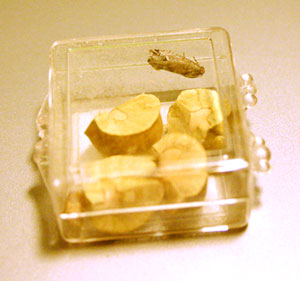I thought my Mexican jumping beans were really cool when I got them. They would hop around in my hand, and it felt weird. I liked to hear them chattering in their little plastic box on my desk while I worked at the computer. But now I have a problem:

I looked in the box tonight, and one of the little worms inside that make the beans jump had turned into a little bitty moth. You can see it near the top of the box in the picture above.
Here is the cocoon it came out of:

It’s hard to see, but it’s in the upper left, just above the top left bean.
(My jumping bean pictures are not very good, because I don’t have a lens for my camera that will take extreme close-ups, and the moth is very little — maybe a centimeter long. To see better pictures, go here.)
I don’t know how to take care of a jumping bean moth. I don’t live in the Sonoran desert. I don’t have any Sebastiana pavoniana shrubs in my yard. I don’t know what jumping bean moths like to eat. And my mom says I should kill the moth, because it might decide it likes to eat my garden. I don’t want to squish my moth. And I don’t want to leave it in that tiny plastic box to suffocate. But I don’t want to be responsible for unleashing an invasive species on Red Fork, either.
Maybe I should get some cotton balls and rubbing alcohol tomorrow and make a kill jar like we used for fruit flies in biology class. I don’t want to asphyxiate my moth with alcohol fumes, but I don’t know what else to do with it, and I think that’s the fastest way to kill it without hurting it.
I feel pretty rotten about it, though. I purposely bought it when it was a baby so I could watch it make an S. pavoniana seed hop around. I thought it was neat. I didn’t think about what would happen when it hatched.
It says here that I don’t have to worry about feeding my moth, because it will only live a few days after it hatches and will not eat during that time — apparently they just live long enough to find a mate and lay some eggs on a jumping bean bush. That makes me feel a little better. Another page on the Beans That Jump site says that Laspeyresia saltitans (jumping bean moth) larvae usually only survive for three to five months, and I’ve had mine since September, so maybe they liked it on my desk and lived longer than they would otherwise. But I still think I am not going to buy any more Mexican jumping beans.
They’re interesting, and they are fun to play with, but I don’t think it’s a very good idea to take a creature out of its natural environment and export it to another country where you know it can’t survive just so people can look at it.
I’m going to keep my Mexican jumping bean hulls as a reminder to think about what I buy and make sure I’m not practicing gratuitous cruelty or endangering the environment just to satisfy my own curiosity about another species.
Emily
